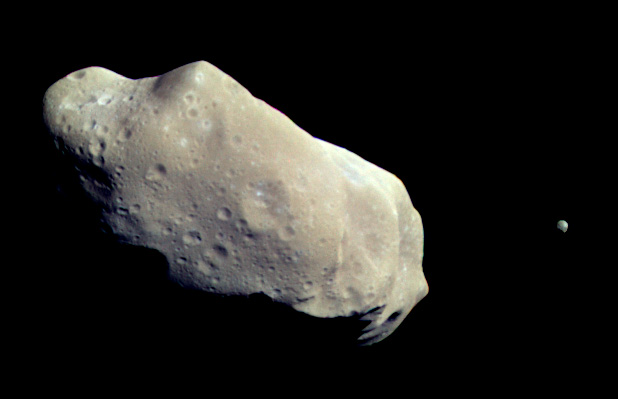| Deskribapena243 ida crop.jpg |
English: This color picture is made from images taken by the imaging system on the Galileo spacecraft about 14 minutes before its closest approach to asteroid 243 Ida on August 28, 1993. The range from the spacecraft was about 10,500 kilometers (6,500 miles). The images used are from the sequence in which Ida's moon was originally discovered; the moon is visible to the right of the asteroid. This picture is made from images through the 4100-angstrom (violet), 7560 A (infrared) and 9680 A (infrared) filters. The color is 'enhanced' in the sense that the CCD camera is sensitive to near infrared wavelengths of light beyond human vision; a 'natural' color picture of this asteroid would appear mostly gray. Shadings in the image indicate changes in illumination angle on the many steep slopes of this irregular body as well as subtle color variations due to differences in the physical state and composition of the soil (regolith). There are brighter areas, appearing bluish in the picture, around craters on the upper left end of Ida, around the small bright crater near the center of the asteroid, and near the upper right-hand edge (the limb). This is a combination of more reflected blue light and greater absorption of near infrared light, suggesting a difference in the abundance or composition of iron-bearing minerals in these areas. Ida's moon also has a deeper near-infrared absorption and a different color in the violet than any area on this side of Ida. The moon is not identical in spectral properties to any area of Ida in view here, though its overall similarity in reflectance and general spectral type suggests that it is made of the same rock types basically. These data, combined with study of further imaging data and more detailed spectra from the Near Infrared Mapping Spectrometer, may allow scientists to determine whether the larger parent body of which Ida, its moon, and some other asteroids are fragments was a heated, differentiated object or made of relatively unaltered primitive chondritic material.
Català: Aquesta imatge en color està feta a partir del sistema de imatges de la nau Galileu uns 14 minuts abans de la seva màxima aproximació al asteroide 243 Ida el 28 d'agost de 1993. El rang des de la nau era d'uns 10.500 quilometres (6.500 milles). Les imatges usades són de la seqüència en la que la lluna de Ida fou originalment descoberta; la lluna és visible a la dreta del asteroide. Aquesta imatge està feta a partir de imatges festes amb filtres de 4100 angstrom (violat), 7560 A (infraroig) i 9680 A (infraroig). El color està 'reforçat' en el sentit de que la càmera CCD és sensible a les ones de llum del infraroig proper més allà de la visió humana; una imatge de color 'natural' d'aquest asteroide seria més grisa. Les ombres a la imatge indiquen canvis en l'angle d'il·luminació on les escarpes molt inclinades del cos irregular així com les variacions subtils de color degudes a les diferències en el estat físic i composició del sol (regolit). Hi ha àrees brillants, que semblen blaves a la fotografia, voltant els cràters en la part més alta a l'esquerra d'Ida, voltant el petit brillant cràter aprop del centre de l'asteroide, i aprop del límit de la dreta a alt (el limbe). Això és una combinació de la llum més blava reflectida i una major absorció de la llum de l'infraroig proper, la qual cosa suggereix una diferència en l'abundància o la composició de minerals que contenen ferro en aquestes àrees. La lluna d'Ida també té una absorció en l'infraroig proper més profunda i un color diferent en el violeta que qualsevol altra àrea d'aquest costat d'Ida. La lluna no és idèntica en les seves característiques espectrals a qualsevol àrea d'Ida tenint en compte que aquí, malgrat la seva similitud global de reflectància espectral i el tipus general suggereix que es feta dels mateix tipus de pedra bàsicament. Aquestes dades, combinades amb l'estudi de les dades més imatges i espectres més detallats a la Espectròmetre d'Infraroig Proper de Mapeig, pot permetre als científics determinar si el cos més gran del que Ida, la seva lluna, i alguns altres asteroides són fragments era un objecte calent, d'objectes diferenciats o fet de material relativament inalterat condrític primitiu.
Deutsch: Asteroid Ida mit Mond Dactyl
Čeština: Planetka (243) Ida se svým měsíčkem Dactylem
Magyar: A Galileo űrszonda fényképe a 243 Idáról. Jobbra halványan látszik a Dactyl.
日本語: ガリレオ探査機が撮影したイダと衛星ダクティル(右の点) |





